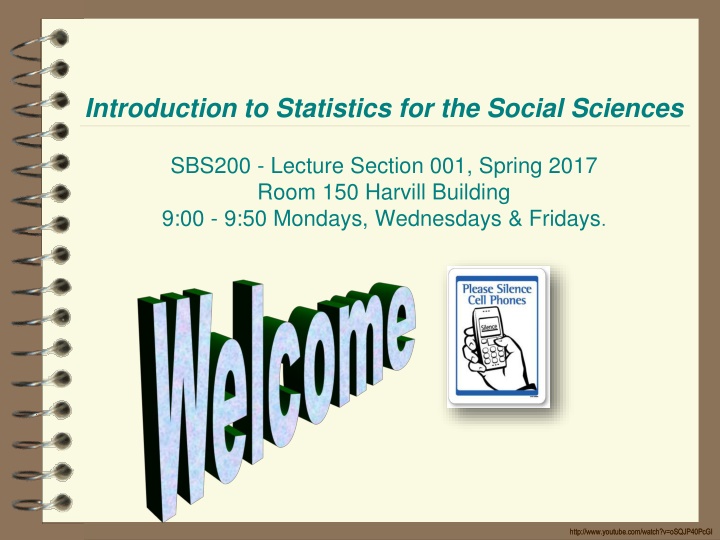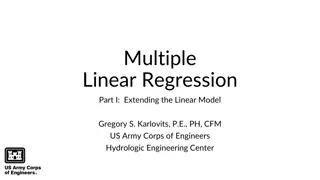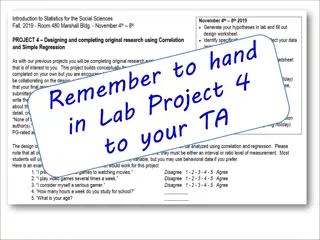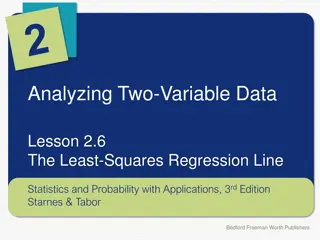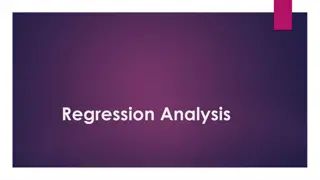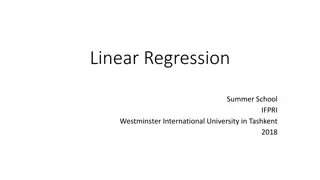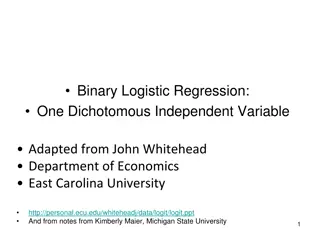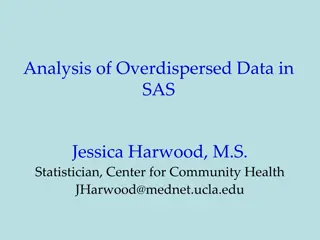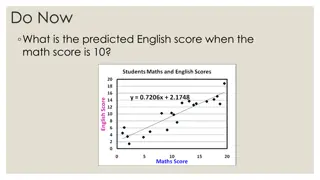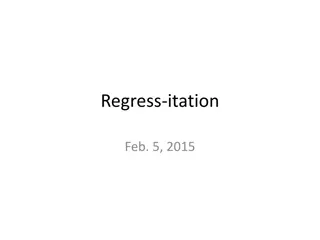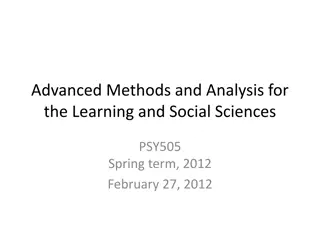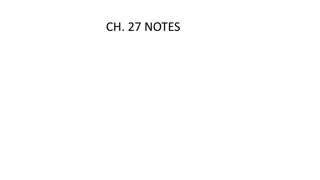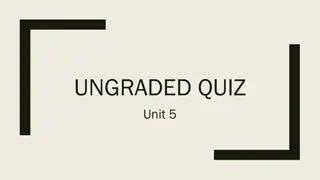Introduction to Statistics for the Social Sciences: Lecture Highlights and Regression Example
This material covers key points from a statistics course for the social sciences, including lecture schedule, readings, and concepts such as residuals, simple regression, correlation, and coefficients. Additionally, a regression example involving predicting sales based on sales calls is presented.
Download Presentation

Please find below an Image/Link to download the presentation.
The content on the website is provided AS IS for your information and personal use only. It may not be sold, licensed, or shared on other websites without obtaining consent from the author.If you encounter any issues during the download, it is possible that the publisher has removed the file from their server.
You are allowed to download the files provided on this website for personal or commercial use, subject to the condition that they are used lawfully. All files are the property of their respective owners.
The content on the website is provided AS IS for your information and personal use only. It may not be sold, licensed, or shared on other websites without obtaining consent from the author.
E N D
Presentation Transcript
Introduction to Statistics for the Social Sciences SBS200 - Lecture Section 001, Spring 2017 Room 150 Harvill Building 9:00 - 9:50 Mondays, Wednesdays & Fridays. http://www.youtube.com/watch?v=oSQJP40PcGI http://www.youtube.com/watch?v=oSQJP40PcGI
Schedule of readings Before our fourth and final exam (May 1st) OpenStax Chapters 1 13 (Chapter 12 is emphasized) Plous Chapter 17: Social Influences Chapter 18: Group Judgments and Decisions
Homework on class website: No homework due Friday, April 21st
Everyone will want to be enrolled in one of the lab sessions Project 4
By the end of lecture today 4/19/17 Residuals Simple Regression Using correlation for predictions r versus r2 Regression uses the predictor variable (independent) to make predictions about the predicted variable (dependent) Coefficient of correlation is name for r Coefficient of determination is name for r2 (remember it is always positive no direction info) Standard error of the estimate is our measure of the variability of the dots around the regression line (average deviation of each data point from the regression line like standard deviation) Coefficient of regression will b for each variable (like slope)
Regression Example Rory is an owner of a small software company and employs 10 sales staff. Rory send his staff all over the world consulting, selling and setting up his system. He wants to evaluate his staff in terms of who are the most (and least) productive sales people and also whether more sales calls actually result in more systems being sold. So, he simply measures the number of sales calls made by each sales person and how many systems they successfully sold.
Regression: Predicting sales You should sell 32.105 systems Step 1: Predict sales for a certain number of sales calls Madison Step 2: State the regression equation Y = a + bx Y = 20.526 + 11.579x Joshua If make one sales call Step 3: Solve for some value of Y Y = 20.526 + 11.579(1) Y = 32.105 What should you expect from a salesperson who makes 1 calls? They should sell 32.105 systems If they sell more over performing If they sell fewer underperforming
Regression: Predicting sales You should sell 43.684 systems Step 1: Predict sales for a certain number of sales calls Isabella Step 2: State the regression equation Y = a + bx Y = 20.526 + 11.579x Jacob If make two sales call Step 3: Solve for some value of Y Y = 20.526 + 11.579(2) Y = 43.684 What should you expect from a salesperson who makes 2 calls? They should sell 43.68 systems If they sell more over performing If they sell fewer underperforming
Regression: Predicting sales You should sell 55.263 systems Ava Step 1: Predict sales for a certain number of sales calls Emma Step 2: State the regression equation Y = a + bx Y = 20.526 + 11.579x If make three sales call Step 3: Solve for some value of Y Y = 20.526 + 11.579(3) Y = 55.263 What should you expect from a salesperson who makes 3 calls? They should sell 55.263 systems If they sell more over performing If they sell fewer underperforming
Regression: Predicting sales You should sell 66.84 systems Step 1: Predict sales for a certain number of sales calls Emily Step 2: State the regression equation Y = a + bx Y = 20.526 + 11.579x If make four sales calls Step 3: Solve for some value of Y Y = 20.526 + 11.579(4) Y = 66.842 What should you expect from a salesperson who makes 4 calls? They should sell 66.84 systems If they sell more over performing If they sell fewer underperforming
Regression: Evaluating Staff Step 1: Compare expected sales levels to actual sales levels Ava Emma Isabella Emily Madison What should you expect from each salesperson Joshua Jacob They should sell x systems depending on sales calls If they sell more over performing If they sell fewer underperforming
Regression: Evaluating Staff Step 1: Compare expected sales levels to actual sales levels 70-55.3=14.7 Difference between expected Y and actual Y is called residual (it s a deviation score) Ava 14.7 How did Ava do? Ava sold 14.7 more than expected taking into account how many sales calls she made over performing
Regression: Evaluating Staff Step 1: Compare expected sales levels to actual sales levels 20-43.7=-23.7 Difference between expected Y and actual Y is called residual (it s a deviation score) Ava How did Jacob do? -23.7 Jacob sold 23.684 fewer than expected taking into account how many sales calls he made under performing Jacob
Regression: Evaluating Staff Step 1: Compare expected sales levels to actual sales levels Ava Emma Isabella Emily Madison What should you expect from each salesperson Joshua Jacob They should sell x systems depending on sales calls If they sell more over performing If they sell fewer underperforming
Regression: Evaluating Staff Step 1: Compare expected sales levels to actual sales levels Difference between expected Y and actual Y is called residual (it s a deviation score) Ava 14.7 Emma Isabella -6.8 Emily Madison -23.7 7.9 Joshua Jacob
Does the prediction line perfectly the predicted variable when using the predictor variable? No, we are wrong sometimes How can we estimate how much error we have? Exactly? Difference between expected Y and actual Y is called residual (it s a deviation score) 14.7 How would we find our average residual ? -23.7 The green lines show how much error there is in our prediction line how much we are wrong in our predictions
Residual scores How do we find the average amount of error in our prediction Ava is 14.7 Jacob is -23.7 Emily is -6.8 Madison is 7.9 The average amount by which actual scores deviate on either side of the predicted score Step 1: Find error for each value (just the residuals) Y Y Difference between expected Y and actual Y is called residual (it s a deviation score) Step 2: Add up the residuals Big (Y Y ) = 0 problem Square the deviations 2 (Y Y ) x How would we find our average residual ? N Square root 2 (Y Y ) The green lines show how much error there is in our prediction line how much we are wrong in our predictions Divide by df n - 2
How do we find the average amount of error in our prediction Deviation scores Diallo is 0 Preston is 2 Mike is -4 Hunter is -2 Step 1: Find error for each value (just the residuals) Y Y Step 2: Find average Difference between expected Y and actual Y is called residual (it s a deviation score) (Y Y )2 n - 2 How would we find our average residual ? x N The green lines show how much error there is in our prediction line how much we are wrong in our predictions
Standard error of the estimate (line) = These would be helpful to know by heart please memorize these formula
How well does the prediction line predict the predicted variable when using the predictor variable? Standard error of the estimate (line) What if we want to know the average deviation score ? Finding the standard error of the estimate (line) Standard error of the estimate: a measure of the average amount of predictive error the average amount that Y scores differ from Y scores a mean of the lengths of the green lines Slope doesn t give variability info Intercept doesn t give variability info Correlation r does give variability info Residuals do give variability info
A note about curvilinear relationships and patterns of the residuals How well does the prediction line predict the Ys from the Xs? Residuals Shorter green lines suggest better prediction smaller error Longer green lines suggest worse prediction larger error Why are green lines vertical? Remember, we are predicting the variable on the Y axis So, error would be how we are wrong about Y (vertical)
Does the prediction line perfectly the predicted variable when using the predictor variable? No, we are wrong sometimes How can we estimate how much error we have? 14.7 Difference between expected Y and actual Y is called residual (it s a deviation score) -23.7 The green lines show how much error there is in our prediction line how much we are wrong in our predictions Perfect correlation = +1.00 or -1.00 Each variable perfectly predicts the other No variability in the scatterplot The dots approximate a straight line
Regression Analysis Least Squares Principle When we calculate the regression line we try to: minimize distance between predicted Ys and actual (data) Y points (length of green lines) remember because of the negative and positive values cancelling each other out we have to square those distance (deviations) so we are trying to minimize the sum of squares of the vertical distances between the actual Y values and the predicted Y values
Is the regression line better than just guessing the mean of the Y variable? How much does the information about the relationship actually help? Which minimizes error better? How much better does the regression line predict the observed results? r r2 2
Some useful terms Regression uses the predictor variable (independent) to make predictions about the predicted variable (dependent) Coefficient of correlation is name for r Coefficient of determination is name for r2 (remember it is always positive no direction info) Coefficient of regression is name for b Residual is found by y y Standard error of the estimate is our measure of the variability of the dots around the regression line (average deviation of each data point from the regression line like standard deviation)
Rorys Regression: Predicting sales from number of visits (sales calls) Describe relationship Regression line (and equation) r = 0.71 Correlation: This is a strong positive correlation. Sales tend to increase as sales calls increase Predict using regression line (and regression equation) b = 11.579 (slope) Slope: as sales calls increase by 1, sales should increase by 11.579 Dependent Variable Intercept: suggests that we can assume each salesperson will sell at least 20.526 systems a = 20.526 (intercept) Independent Variable
50% is explained so the other 50% has yet to be explained (0.71 > 0.632)
Summary Slope: as sales calls increase by one, 11.579 more systems should be sold Intercept: suggests that we can assume each salesperson will sell at least 20.526 systems
What is regression used for? Include and example Regressions are used to take advantage of relationships between variables described in correlations. We choose a value on the independent variable (on x axis) to predict values for the dependent variable (on y axis).
Regressions use correlations to make predictions. Two numeric variables represented by scatterplots make predictions and not just describe the relationhsip Residuals are the difference between our predicted y (y ) and the actual y data points. A positive residual score means that they earned more than expected given the hours that they worked. A negative score means they earned less than expected
What is a residual? How would you find it? Residuals are the difference between our predicted y (y ) and the actual y data points. Once we choose a value on our independent variable and predict a value for our dependent variable, we look to see how close our prediction was. We are measuring how wrong we were, or the amount of error for that guess. Y Y = residual score
Regressions use correlations to make predictions. Two numeric variables represented by scatterplots make predictions and not just describe the relationhsip Residuals are the difference between our predicted y (y ) and the actual y data points. A positive residual score means that they earned more than expected given the hours that they worked. A negative score means they earned less than expected It is the average of the values for all of the residuals
What is Standard Error of the Estimate (How is it related to residuals?) The average length of the residuals The average error of our guess The average length of the green lines The standard deviation of the regression line
Regressions use correlations to make predictions. Two numeric variables represented by scatterplots make predictions and not just describe the relationhsip Residuals are the difference between our predicted y (y ) and the actual y data points. A positive residual score means that they earned more than expected given the hours that they worked. A negative score means they earned less than expected It is the average of the values for all of the residuals Square the r value in the annual salary that is due to hours worked is 49%
Give one fact about r2 It is called a coefficient of determination It is the square of the value for r It is the proportion of variance of the dependent variable that is accounted for by its relationship with the independent variable
Regressions use correlations to make predictions. Two numeric variables represented by scatterplots make predictions and not just describe the relationhsip Residuals are the difference between our predicted y (y ) and the actual y data points. A positive residual score means that they earned more than expected given the hours that they worked. A negative score means they earned less than expected It is the average of the values for all of the residuals Square the r value in the annual salary that is due to hours worked is 49%
